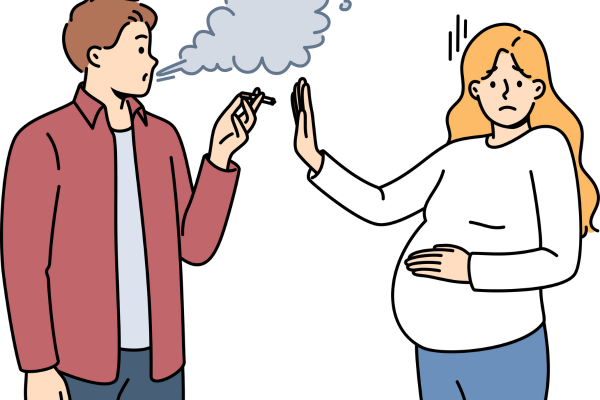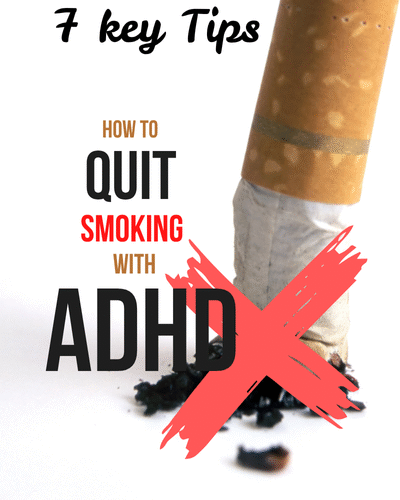Quitting weed is tough, and if you have ADHD, it can feel even harder. The impulsivity, restlessness, and constant need for stimulation that often come with ADHD can make it more difficult to break the habit.
In this guide, How to Quit Smoking Weed with ADHD, we’ll walk you through six practical, ADHD-friendly tips to help you stay focused, manage cravings, and build healthier habits. These strategies are designed to work with your brain.
Table of Contents
ToggleWhy ADHD and Marijuana Are Closely Linked
ADHD (Attention-Deficit/Hyperactivity Disorder) is a neurodevelopmental condition that affects how the brain manages focus, attention, emotional regulation, and impulse control. People with ADHD often struggle with restlessness, trouble concentrating, forgetfulness, and strong emotional reactions.
One of the key challenges is how ADHD affects the brain’s dopamine system, the chemical responsible for feelings of reward, motivation, and pleasure. Lower dopamine activity in the brain means that everyday tasks can feel boring, unmotivating, or overwhelming. This creates a constant search for stimulation or relief.
That’s where marijuana often comes in. Cannabis can temporarily boost dopamine, helping people with ADHD feel calmer, more focused, or emotionally balanced, at least for a while. For many, it becomes a go-to coping mechanism.
But over time, this short-term relief can lead to long-term dependence. Quitting becomes harder because weed has been filling in for something the brain naturally lacks.
 Why Do People With ADHD Often Use Marijuana and What’s the Connection?
Why Do People With ADHD Often Use Marijuana and What’s the Connection?
Many people with ADHD use marijuana as a way to cope with symptoms like restlessness, anxiety, and insomnia. The calming effect offers temporary relief from the racing thoughts and overwhelm that are common with ADHD.
For some, it provides a sense of focus or emotional balance that they struggle to find elsewhere. Over time, this temporary relief can become a regular habit, even though the long-term impact on attention and memory may be more harmful than helpful.
What makes the connection between ADHD and marijuana use more complex is how the brain responds to both. ADHD involves lower levels of dopamine, the chemical that affects motivation and reward.
Marijuana can temporarily increase dopamine, which might explain why it feels helpful at first. But frequent use can disrupt natural dopamine production, making symptoms worse over time. This can create a cycle where a person uses weed to feel better, but ends up feeling even more unfocused, unmotivated, or emotionally unstable when not using.
Recognizing why you rely on weed is a crucial first step in quitting, especially if you have ADHD. Many people use marijuana not just for the high, but to temporarily manage symptoms like anxiety, restlessness, difficulty focusing, or emotional overwhelm. Understanding this pattern helps shift the focus from simply quitting to actually addressing the underlying needs driving the habit.
The goal isn’t just to stop smoking, it’s to replace weed with healthier, more sustainable ways to manage ADHD. That might mean working with a therapist, creating structure through daily routines, or using ADHD-friendly tools like timers, planners, and movement breaks.
Can Marijuana Treat ADHD?
There’s ongoing debate about whether marijuana can help treat ADHD symptoms, but the research so far is limited and mixed. Some people with ADHD report feeling calmer, more focused, or less anxious after using cannabis.
These personal experiences have led to the belief that marijuana might help manage symptoms, especially for those who haven’t found relief with traditional treatments.
However, scientific studies haven’t consistently supported this idea. Most research shows that marijuana use can impair attention, memory, and motivation. While it might feel like marijuana helps in the short term, especially with sleep or anxiety, regular use can create new problems.
Over time, cannabis can lead to dependence, reduced cognitive function, and emotional ups and downs. For those looking into how to quit smoking weed with ADHD, it’s important to know that cannabis isn’t a medically approved treatment for ADHD, and its risks often outweigh the potential benefits.
Is ADHD Linked to a Higher Risk of Cannabis Use Disorder?
Research shows that people with ADHD may be at a higher risk of developing Cannabis Use Disorder compared to the general population. This could be due to a mix of neurological, emotional, and behavioral factors.
ADHD often comes with impulsivity, emotional regulation issues, and a tendency to seek stimulation, traits that can make someone more likely to use substances like marijuana regularly. While it might feel like weed helps with restlessness or anxiety in the short term, over time, it can lead to dependence.
Learning how to quit smoking weed with ADHD involves more than just stopping cannabis use; it requires building healthier coping tools and understanding your triggers. Many people with ADHD find it hard to manage stress, boredom, or sleep without turning to weed, especially if they’ve used it for years.
Trying to Give up Smoking Weed? Start Here
Quitting weed can be difficult for people with ADHD, and brain chemistry is a part of the reason. ADHD is linked to lower levels of dopamine, the brain chemical that plays a key role in motivation, reward, and focus. Because of this, everyday tasks can feel boring, frustrating, or even impossible to start.
Marijuana can temporarily boost dopamine levels, creating a short-lived sense of calm, pleasure, or relief. For someone with ADHD, that quick boost can feel like the only thing that helps them slow down, unwind, or get through the day. Over time, it’s easy to start relying on weed as a way to self-medicate, especially when life feels overwhelming or under-stimulating.
Another challenge is the struggle with structure and consistency. Many people with ADHD have trouble sticking to routines, remembering long-term goals, or managing stress in healthy ways. Weed often becomes a go-to solution for anxiety, improving sleep, or avoiding boredom.
Without a clear plan, the same ADHD challenges that make daily life harder—like impulsivity, forgetfulness, and low motivation- can also derail attempts to quit weed. That’s why quitting successfully means more than just deciding to stop.
That’s why quitting isn’t just about willpower or breaking a habit. It’s about finding healthier, more sustainable ways to support your brain’s need for stimulation, structure, and reward. That includes breaking your goals into small, manageable steps, using visual cues and reminders to stay on track, and creating external systems of support, accountability partners, routines, or therapy that help you stay consistent, even when your motivation drops.
Emotional regulation is another major factor when it comes to quitting weed with ADHD. People with ADHD often feel emotions more intensely and have a harder time managing them. This is why it is important to explore healthy coping tools to avoid falling back into old habits.
 How Does Marijuana Use Affect The Brain?
How Does Marijuana Use Affect The Brain?
Marijuana affects the brain by altering how it processes information, emotions, and motivation. THC, the active chemical, interacts with the brain’s endocannabinoid system, which influences mood, memory, and attention. This impact is stronger in younger brains, especially those still developing. That’s why learning how to quit smoking weed with ADHD early can make a real difference.
Regular use can lower dopamine levels over time, making it harder to feel motivated or focused without weed. For someone with ADHD, who already struggles with these areas, it can create a deeper dependence.
Marijuana can also impair short-term memory and slow reaction times. This may not seem like a big deal at first, but over time, it can interfere with work, relationships, and daily routines.
Chronic use may increase anxiety, paranoia, or mood swings, especially if someone starts relying on weed to manage ADHD symptoms. These effects can be confusing and discouraging, making quitting feel even harder.
That’s why knowing how to quit smoking weed with ADHD includes having a clear, realistic plan for handling emotions without turning to cannabis.
How Does Weed Affect the ADHD Brain Over Time?
Weed can have a unique and often harmful effect on the ADHD brain over time. While it might feel like it helps with focus or anxiety in the short term, long-term use can reduce dopamine levels even further.
This can worsen symptoms like lack of motivation, poor focus, and emotional instability. Since ADHD already involves challenges with executive function, regular marijuana use can make it even harder to stay organized, follow through on tasks, or manage time, issues that are central when figuring out how to quit smoking weed with ADHD in a lasting way.
Over time, the brain may start to rely on marijuana to feel calm, which can lead to dependence. The ADHD brain is wired to seek stimulation, and weed can temporarily satisfy that need. But as tolerance builds, the same amount no longer has the same effect, leading to frequent use.
Is Marijuana Addictive?
Yes. Marijuana can be addictive, especially with regular and long-term use. While not everyone who uses weed becomes dependent, studies show that around 1 in 10 users will develop Cannabis Use Disorder, and the risk is higher for those who start young or use daily.
For people with ADHD, the chances may be even greater due to the brain’s craving for stimulation and difficulty with impulse control.
Marijuana addiction often looks different from other substances, which makes it easier to overlook. It might show up as needing weed to relax, sleep, focus, or feel normal.
Withdrawal symptoms like irritability, low mood, and insomnia can also make quitting difficult, especially for someone already managing ADHD symptoms. A strong plan for how to quit smoking weed with ADHD needs to include tools for managing withdrawal.
How To Help Someone Else Stop Smoking Weed?
Helping someone stop smoking weed can be tough, especially if they don’t see it as a problem or are using it to cope with something deeper, like ADHD.
The first step is to approach the situation with empathy. If their use is tied to focus, sleep, or managing stress, it’s often more helpful to talk about what they’re struggling with, not just the weed itself. This kind of approach is also key when figuring out how to quit smoking weed with ADHD, since the habit is often linked to symptom management.
Once you’ve opened up that conversation, support them in creating a plan, not just telling them to stop. Encourage small, realistic changes, such as reducing the number of weeds daily.
Quitting weed, especially when it’s tied to mental health or attention issues, isn’t an easy path. Your role isn’t to control or force, but to offer steady support and resources. Be consistent, celebrate progress.
What Role Does Dopamine Play in ADHD and Weed Addiction?
Dopamine is a key brain chemical involved in motivation, reward, and focus—all areas where people with ADHD often struggle. Low dopamine activity makes it harder to stay engaged with tasks or feel a sense of satisfaction from everyday accomplishments.
Marijuana temporarily boosts dopamine levels, which is why it can feel calming or mentally stimulating at first. But over time, regular use can reduce the brain’s natural dopamine production. This makes it even harder to concentrate or feel motivated without weed.
A more effective way to quit smoking weed with ADHD is to focus on replacing it with healthy sources of dopamine, like regular exercise, structured daily routines, and meaningful goals. These alternatives not only boost motivation but also support long-term focus, emotional balance, and overall mental well-being.
 How to Help Teens Who Rely on Cannabis?
How to Help Teens Who Rely on Cannabis?
One of the most effective ways to help teens avoid or quit cannabis use is to start the conversation early. Teens are less likely to experiment with marijuana when they clearly understand your values and expectations. Explain that even if laws change, marijuana still harms the developing brain.
Many teens think marijuana is safe because it’s “natural,” but using it before 18 increases the risk of addiction and can lower IQ. It’s also linked to poor grades and dropping out. During your conversations, calmly go over these facts.
Explain how marijuana affects brain function differently in teens than in adults, and emphasize that everyone responds differently. Some may feel relaxed, while others might experience panic attacks or even psychosis. The more informed your teen is, the more empowered they are to make smart decisions.
Teens are more likely to avoid marijuana when parents or caregivers model healthy, responsible behavior, including staying away from drug use themselves. Beyond conversations, stay engaged in your teen’s daily life.
Know who they’re spending time with, stay involved in school activities, and build relationships with their friends’ parents. Watch for red flags such as sudden changes in behavior, slipping grades, or emotional withdrawal.
Most importantly, support their self-esteem by noticing and praising their positive behavior. When teens feel seen, supported, they’re more likely to resist peer pressure and less likely to turn to substances to cope.
What Should You Do When Your Teen Says Weed Is the Only Thing That Helps?
When a teen says weed is the only thing that helps, it’s important to listen without immediately reacting with anger or judgment. This statement comes from a place of frustration. Try to understand what exactly the weed is helping with, whether anxiety, sleep, stress, or difficulty focusing.
For teens with ADHD, this claim can be even more complex, since they may be using marijuana to cope with symptoms they don’t know how to manage. Before talking about how to quit smoking weed with ADHD, focus on building trust and opening up a real conversation.
Once they feel heard, gently start exploring other ways they might get relief without relying on weed. You don’t have to dismiss their experience, but you can guide them toward healthier options, like therapy, physical activity, or medication, depending on what they’re struggling with.
Teens with ADHD often benefit from routines, structure, and emotional support, all of which can play a huge role in helping them feel more in control. Helping them discover how to quit smoking weed with ADHD means showing them that other ways exist and that those ways can work.
It’s also useful to get professional support, especially if they’re resistant to change or struggling emotionally. A mental health provider who understands both ADHD and substance use can help them feel less alone and more supported.
Can You Treat ADHD Without Relying on Weed?
Yes, ADHD can be treated without relying on weed. While marijuana might seem to offer quick relief, it doesn’t address the root causes of ADHD and can even make symptoms worse over time. There are proven, healthier options like behavioral therapy, structured routines, exercise, and ADHD-specific medication.
These methods are far more effective in the long run and don’t come with the same cognitive side effects. Many people with ADHD turn to weed because they feel like nothing else works. But often, that’s because they haven’t had access to the right support, or they’ve had a bad experience with treatment in the past. The key is finding what fits your lifestyle and brain, not just masking symptoms with marijuana.
What is the best approach to quit smoking weed?
The best approach to quit smoking weed is by identifying why you use weed, whether it’s for stress relief, boredom, sleep, or managing ADHD symptoms. Once you know what you’re using it for, it becomes easier to find healthier ways to meet those same needs. This is especially important when figuring out how to quit smoking weed with ADHD, since the habit is often tied to deeper struggles.
Next, create a step-by-step plan that’s realistic for your lifestyle. That might mean cutting back gradually, removing triggers from your environment, or setting short-term goals to stay motivated. Building new habits like exercising or keeping a consistent schedule can help reduce the urge to use.
For someone with ADHD, those tools are essential. Learning how to quit smoking weed with ADHD also means finding ways to structure your day so it supports your brain.
Talk to a therapist, join a support group, or tell someone you trust. Accountability and encouragement make a huge difference, especially when withdrawal or cravings hit. People with ADHD may need extra support to stay focused and emotionally regulated during the process.
 How Can You Manage ADHD Symptoms Without Using Cannabis?
How Can You Manage ADHD Symptoms Without Using Cannabis?
Managing ADHD without relying on cannabis is possible; it just takes the right tools and a clear plan. Many people use weed to ease frustration or fall asleep, but those effects are short-lived and can lead to bigger problems over time.
Start by identifying which ADHD symptoms affect you the most. Knowing your main challenges helps you find better ways to cope. This clarity makes it easier to replace weed with healthier strategies that work in the long run.
Routine and structure are key tools for managing ADHD without relying on cannabis. Regular sleep, consistent meal times, exercise, and a daily plan can all help regulate energy and focus levels.
For people with ADHD, ADHD coaching, therapy like CBT, or finding the right medication with a doctor can help you manage symptoms more effectively than cannabis ever could.
How to Quit Smoking Weed With ADHD: 7 Key Tips
There are several methods approved by the Food and Drug Administration (FDA) to help you quit smoking. They work in different ways. All are safe and effective for adults who smoke cigarettes.
- Nicotine Replacement Therapy (NRT)
For those quitting tobacco or cannabis smokers looking to manage the habit of smoking, NRT can be a helpful tool. Products like nicotine patches provide a steady dose through the skin, while nicotine gum or lozenges offer quick relief during cravings.
There are also fast-acting options like nicotine inhalers or nasal sprays. While designed for tobacco, some cannabis users find these products useful when trying to reduce the hand-to-mouth habit.
- Prescription Medications
Medications such as Bupropion and Varenicline are FDA-approved to help with quitting tobacco, but under a doctor’s supervision, they may also ease cannabis withdrawal symptoms. Bupropion can reduce cravings and also support mood stability, which is helpful for those with ADHD. Always consult a healthcare provider before using these for cannabis cessation.
- Behavioral Therapy or Counseling
Working with a therapist can be one of the most powerful ways to quit. Cognitive-behavioral therapy (CBT) helps you understand your triggers and build coping strategies. ADHD-informed therapy can address attention, impulsivity, and emotional regulation, common issues for those quitting weed. Support groups and addiction counselors offer ongoing guidance and accountability.
- Mobile Apps and Online Support Tools
Tech-savvy users can benefit from quit-smoking apps that track progress, send motivational reminders, and offer daily support. Online communities also provide a place to share struggles and successes with others who understand.
- Healthy Lifestyle Changes
Replacing smoking with healthy habits is key to long-term success. Exercise, even just walking, boosts mood and increases dopamine naturally. Mindfulness practices, chewing gum, or using stress balls can help manage urges. Staying hydrated, eating balanced meals, and creating a smoke-free environment all support your quit journey, especially for ADHD brains that thrive on structure and stimulation.
- Cold Turkey (Quitting Without Aids)
Some people prefer to quit suddenly without medications or external aids. This can work well if you’re highly motivated and have strong support. Choosing a quit date, removing smoking tools, and having someone to hold you accountable can increase your chances of success. This method can be tough, but it’s effective for those ready to commit 100%.
- Combining Strategies for Best Results
Often, the most effective approach is to combine multiple tools. For example, you might pair behavioral therapy with lifestyle changes, or use an app alongside nicotine gum.
If you have ADHD, combining structure with emotional support and healthy stimulation can make a big difference. Personalizing your quit plan increases the chance of long-term success.
What Triggers Should You Watch Out for When Trying to Quit Weed With ADHD?
Here are the key triggers to watch out for when trying to quit weed with ADHD.
-
Boredom
People with ADHD often seek stimulation, and when things feel slow or repetitive, the urge to use weed can increase. Filling your day with engaging, structured activities can help reduce this trigger. -
Stress and Emotional Overload
Weed is commonly used to escape anxiety, frustration, or emotional dysregulation. Learning healthier ways to manage stress supports your progress in how to quit smoking weed with ADHD. -
Lack of Routine
A disorganized day can lead to impulsive decisions. ADHD thrives on structure, so sticking to a routine helps reduce decision fatigue and lowers the chances of relapse. -
Social Pressure or Environment
Being around people who use weed or in settings where it’s easily available can make quitting harder. Taking a break from those environments, or finding new ones, can strengthen your resolve. -
Sleep Problems
Many people with ADHD use weed to fall asleep. Finding other strategies like melatonin, guided meditations, or screen-free wind-down routines can make a big difference in how to quit smoking weed with ADHD without sacrificing rest. -
Negative Self-Talk
Feeling like a failure or doubting your ability to change can trigger use. Practicing self-compassion and focusing on progress rather than perfection keeps you moving forward.
What can I do instead of smoking weed?
Here are several effective alternatives to smoking weed, especially for people managing ADHD. Each one supports the broader goal of how to quit smoking weed with ADHD by replacing the habit with healthier, more sustainable options:
-
Exercise
Exercise is the best natural replacement for weed because it releases dopamine and boosts focus, mood, and stress relief. Pick what you enjoy: walking, lifting weights, yoga, or team sports. Registering at a gym helps you build a consistent routine and gives you access to a variety of workout equipment. Hiring a personal trainer adds structure and accountability, making it easier to stay on track. -
Creative Hobbies
Please get involved in creative or hands-on activities, such as drawing, playing music, writing, or baking, as they provide healthy mental stimulation. These hobbies not only keep your mind engaged but also help prevent boredom, a common trigger for reaching for weed. -
Mindfulness Practices
Activities like deep breathing, short guided meditations, or mindfulness journaling help reduce impulsivity and improve emotional regulation. Adding mindfulness into your daily routine is a powerful support tool in how to quit smoking weed with ADHD and staying in control of your thoughts and choices. -
Structured Daily Routine
ADHD and lack of structure often go hand in hand, and downtime can become a trigger. Creating a simple, predictable schedule with clear priorities and breaks can help reduce the chances of reaching for weed out of habit. Having a routine keeps your mind focused and busy, which is key to how to quit smoking weed with ADHD and keeping progress going. -
Social Support
Spending time with people who support your goals can make a huge difference. A friend, a support group, or a therapist helps with accountability and motivation. Knowing you’re not alone in figuring out how to quit smoking weed with ADHD can ease the pressure and make the process feel more manageable.
What Are ADHD-Friendly Strategies for Handling Withdrawal From Weed?
Dealing with weed withdrawal can be especially challenging if you have ADHD, since you may already struggle with emotions, focus, and sleep. In the first few days, it’s common to feel irritable, restless, and have trouble sleeping, and those symptoms can feel even more intense with ADHD.
One of the best ways to manage this is by building a simple, predictable daily routine. Having structure gives your brain something steady to rely on, making it easier to stay focused and reduce stress while you work on quitting for good.
It also helps to break your day into small, manageable chunks. ADHD brains work better with short-term goals and visible progress, so write down tasks or use a timer to stay on track. Regular movement can reduce agitation and help release built-up energy.
When cravings hit, having quick go-to activities like chewing gum, journaling, or doing a five-minute breathing exercise can redirect your focus. These ADHD-friendly strategies don’t just ease withdrawal but help reinforce the process of how to quit smoking weed with ADHD by offering steady ways to manage discomfort without turning back to weed.
 What is the hardest day of quitting weed?
What is the hardest day of quitting weed?
For many people, the hardest days of quitting weed often fall between day two and day four. This is when withdrawal symptoms typically peak, both physically and emotionally. If you’re someone with ADHD, this period can feel especially intense.
During this early phase, your brain is adjusting to the sudden drop in dopamine levels. Weed artificially boosts dopamine, which helps you feel relaxed or focused for a short time. When you stop, your brain has to relearn how to regulate that chemical naturally.
This sudden change can make things like motivation, focus, and emotional control much harder in the short term, especially for ADHD brains, which already struggle with dopamine regulation.
You might experience strong cravings or feel extremely restless, like you can’t sit still. That’s when having a plan becomes your best defense. A simple daily routine, built-in distractions, and knowing what to expect can make those tough moments easier to handle. Remind yourself that these feelings are temporary and that you have tools to get through them.
After the first week, when the physical symptoms start to fade, mental withdrawal often kicks in, and it can be just as challenging. This phase is sneaky because it shows up as boredom or low motivation. For people with ADHD, this can be especially frustrating, since these are the same issues that weed was often used to cope with.
This is the stage where your new habits start to count. ADHD brains constantly seek stimulation, so when weed is no longer providing that boost, it’s essential to find healthier sources. Activities like exercise, creative hobbies, structured routines, or spending time with others actively support your brain in rebuilding its system. These positive habits make it easier to stay focused, feel good, and stay on track long term.
What are the benefits of quitting weed?
Quitting weed can feel overwhelming at first, especially if it’s been part of your daily routine. But once you begin the process, the benefits often come faster and go deeper than expected.
Quitting weed brings emotional stability and better mental health. Although weed might feel like a quick fix for anxiety or mood swings, over time, it can intensify those issues, especially for people with ADHD. Once you stop using it, your brain begins to balance out naturally to cope with stress, boredom, or overwhelm without needing to rely on cannabis to get through the day.
Sleep and energy levels also improve after quitting, even if the first week or two are tough. Many people use marijuana as a sleep aid, but it interferes with deep REM sleep and may cause long-term issues. Once your body adjusts, you’ll likely notice deeper, more restorative sleep and more energy during the day.
Physically, your lungs start to heal if you smoked, and you may notice easier breathing and reduced coughing. When you feel better physically, it becomes easier to stick to routines, exercise more, and take care of yourself overall.
Quitting also leads to improvements in relationships, finances, and overall self-esteem. You become more present and emotionally available to the people around you. Communication improves, and conflicts that may have been worsened by weed use begin to resolve.
Financially, you save money on cannabis and related habits, giving you more freedom to invest in things that truly benefit you. Many people reconnect with their true interests, values, and goals. Life starts to feel more meaningful.
What happens when you quit weed suddenly?
When you stop using weed abruptly, your body and brain can go through withdrawal as they adjust to functioning without THC (the main psychoactive chemical in cannabis). This is if you’ve been using it regularly for a long time.
In the first 24 to 72 hours, you may notice physical symptoms such as headaches, irritability, fatigue, changes in appetite, and trouble sleeping. For some people, these symptoms are mild, but for others, they can feel intense and disruptive, especially if weed has been a daily coping mechanism.
These effects can feel amplified for people with ADHD, who already struggle with regulating emotions, attention, and impulse control. Because cannabis temporarily boosts dopamine and helps soothe overstimulation, your brain may initially struggle to function without it. During this adjustment phase, you might feel like your symptoms are getting worse before they get better. This is normal, and it’s a sign your system is rebalancing.
Over time, these withdrawal symptoms fade, usually within one to two weeks. After that, your body starts to stabilize, and your natural dopamine production begins to bounce back. Your thinking becomes clearer, and your emotional state starts to feel more even.
What is the timeline for weed withdrawal?
The timeline for weed withdrawal can vary from person to person, but most people start noticing symptoms within the first 24 to 72 hours after quitting. During this initial phase, common effects include irritability, trouble sleeping, low mood, and anxiety.
For someone with ADHD, this period can feel especially intense because it disrupts routines and adds extra pressure on emotional control. That’s why early planning and support play a big role in how to quit smoking weed with ADHD successfully.
By the end of the first week, physical symptoms usually begin to ease, but mental cravings can still be strong, especially when triggered by boredom or stress. Weeks two to four often bring emotional ups and downs, along with challenges around focus and motivation.
For many, staying active, building a routine, and using healthier coping tools helps keep things on track. This phase is key in learning how to quit smoking weed with ADHD in a sustainable way, as it’s when new habits start replacing the old ones.
How to quit smoking when you have ADHD?
Quitting smoking can be especially challenging when you have ADHD. Quitting smoking when you have ADHD requires a tailored approach that works with how your brain functions. Because ADHD affects impulse control, emotional regulation, and dopamine levels, it’s important to create structure, use reminders, and build healthy routines that keep your brain engaged.
Start by identifying your triggers, stress, boredom, or overstimulation, and replace smoking with dopamine-boosting alternatives like exercise, creative hobbies, or mindfulness practices. Behavioral therapies such as cognitive-behavioral therapy (CBT) or ADHD coaching can provide valuable tools and accountability.
Medications or nicotine replacements may also help manage cravings. Most importantly, break your goals into small, manageable steps and set a strong support system to stay consistent and motivated.
 When Should You Consider Professional Help to Quit Weed With ADHD?
When Should You Consider Professional Help to Quit Weed With ADHD?
You should also consider professional help if quitting triggers intense withdrawal symptoms like anxiety, depression, insomnia, or mood swings that don’t ease after the first couple of weeks. Therapists, ADHD coaches, and addiction counselors can help you understand your patterns, build new coping tools, and manage both ADHD symptoms and cravings at the same time.
Conclusion
Quitting weed when you have ADHD can be uniquely challenging due to how ADHD affects motivation, impulse control, and emotional regulation. Many people with ADHD turn to cannabis to manage symptoms like restlessness, anxiety, and trouble sleeping.
Marijuana temporarily boosts dopamine, the brain chemical often deficient in ADHD, which creates a short-term sense of relief. However, long-term use can lead to dependence, reduced academic or professional performance, emotional blunting, and even worsened focus over time.
Exercise, creative hobbies, structure, and therapy can help meet the brain’s need for stimulation and regulation. Tools like ADHD-informed CBT, support groups, mobile apps, and even medication (under medical supervision) can reduce withdrawal symptoms and prevent relapse.
Withdrawal can be intense during the first week. Replacing weed with consistent physical activity, engaging activities, social connection, and healthy coping strategies helps the brain adjust.
More on medcareformind
Ettang Utibeabasi
Hello! I'm Utibeabasi Ettang, a dedicated pharmacist with a deep passion for mental health care. Over the past three years, I’ve developed a strong commitment to making mental health care accessible and acceptable to people around the world, especially those who may be silently struggling. My journey in mental health began during my internship at the Federal Neuro-psychiatric Hospital, where I had the opportunity to work alongside various mental health practitioners and researchers. This experience sparked a profound interest in the field, and since then, I've been focused on bridging the gap in mental health care through education and awareness. I’ve had the privilege of organizing training sessions for team members of multiple mental health NGOs, aiming to enhance their understanding and improve the delivery of mental health services. Through these experiences, I’ve come to realize that there’s a significant need for reliable mental health information and support for professionals and the public. My goal with this platform is to provide resources, insights, and support to individuals who are navigating mental health challenges, while also contributing to the global movement of making mental health care more accessible and less stigmatized. Thank you for being here, and I hope this platform serves as a valuable resource in your mental health journey.






